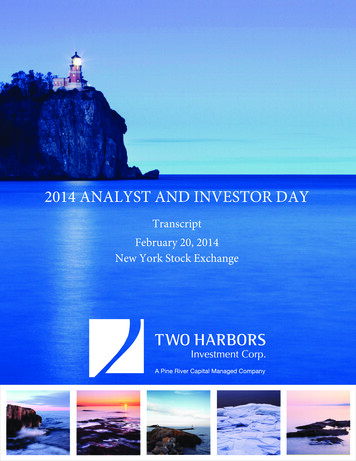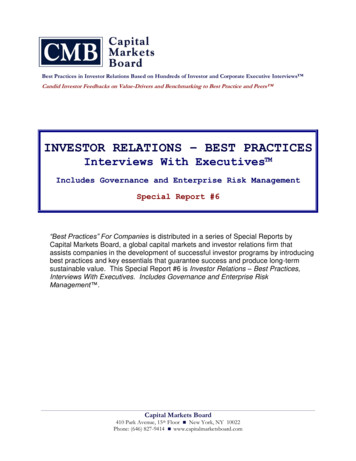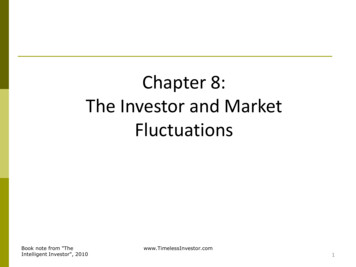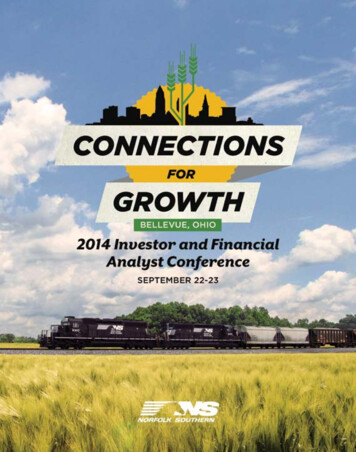
Transcription
2014 ANALYST AND INVESTOR DAYTranscriptFebruary 20, 2014New York Stock Exchange
February 20, 20142014 Analyst and Investor DayJames Grant, Editor, Grants Interest Rate ObserverTom Siering, President and Chief Executive Officer, Two HarborsBrad Farrell, Chief Financial Officer, Two HarborsWilliam Roth, Chief Investment Officer, Two HarborsJuly Hugen, Director of Investor Relations, Two HarborsWELCOMING REMARKS, TOM SIERINGGood morning. For those of you who don’t know me, I am Tom Siering, the CEO of Two Harbors.Welcome and thank you for joining us for Two Harbors 2014 Analyst and Investor Day.We are delighted to have Jim Grant, the founder and editor of Grant’s Interest Rate Observer as ourkeynote speaker today. The Interest Rate Observer is one of the most quoted and influentialpublications on Wall Street. And I have to say for people like Bill and I who been around the marketsfor long time, this is sort of like playing catch with Mickey Mantle. Jim is a highly coveted guest on avariety of television formats. I am also excited to share that he has been recently inducted to theFixed Income Analyst Hall Of Fame. Today, Jim will be addressing the consequences to the marketfrom of Fed’s impact on interest rates which is obviously very topical to the mortgage markets and toTwo Harbors. With that, I am pleased to introduce Jim Grant.JAMES GRANT, GRANTS INTEREST RATE OBSERVERThank you, Tom. Thank you, Bill. Thank you, Two Harbors and welcome to Lower Manhattan. Wehave an office directly across the street, that was why I was ten minutes late. I will now indulge insome special pleading by a fellow who has the words “interest rate” in the name of his publication.We at Grant’s like our interest rates natural. We like green, free range, organic, local, sustainableinterest rates. Instead the Fed insists on giving us the artificial genetically modified hot house kind,you know, supermarket tomatoes in February kind of interest rates. The consequences of theserates and of the more broadly of the Fed reserves assault, I take it to be an assault, on the pricemechanism is the topic of my remarks today.In preview, I intend to describe what our central bank has been up to, review what it has hoped toaccomplish and examine what it has actually achieved and failed to achieve. To see the presentmore clearly, I will lead you on a short temporal detour back to the 1920s. I will touch on the fraughtsubject of deflation and consider the particular ways in which ultra-low rates have distorted thefinancial landscape. And we will break for lunch at 3:00, oh! 2:00, okay.Now, to [indiscernible] the forward-looking tone of these remarks, allow me to quote a few lines fromFrederic Bastiat the great Bastiat who died in 1850, “in the economy” said this immortal, “in theeconomy an act a habit an institution of law gives birth not only to an effect, but also to a serious ofeffects. Of these effects the first only is immediate, it manifests itself simultaneously with its cause,1
February 20, 20142014 Analyst and Investor Dayit is seen. The others unfold in succession, they are not seen. It is well for us if they were forcing.”The seen and the unseen; if only our policymakers would devote a little more time to the latter, to theunseen. So Bastiat of course, learned from Adam Smith who extolled the virtues of the invisiblehand, something we today might call instead free markets or the price mechanism.A couple of years ago, about this time of year, then Chairman Ben Bernanke was at GeorgeWashington University lecturing the students on the ways of the central bank and the ways of theworld. And he gave them kind of a potted history of modern finance and he touched on the episodeof the early 70s in which you will not recall, but perhaps you’ve read about that President Richard M.Nixon instituted wage price controls when the measured rate of inflation was about 4%, 4.5%. Canyou imagine it? A wage-price freeze on the economy imposed from on high. Bernanke discussedthis policy error, he shook his head, he could not prices he said are very important, you can’t just,you can’t just manipulate them.This to me was a telling lack of self-awareness on the part of our intellectually gigantic former FedChairman. What is ZIRP QE, the so-called portfolio balance channel except a kind of price control?The Chairman observed that price control has never worked and we are meant to understand that inthis instance what we are not calling price control, will work. So it strikes me and perhaps you haveobserved that the prices of financial assets increasingly are administered from on high rather thandiscovered from us in the private sector.I’d like to tell you actually given the sophistication of this audience, to remind you about the profoundimportance of this transformation. So let’s start with interest rates such as they are. You CFA’s outthere know full well that the value of a common stock is or ought to be the present value of its futurecash flows discounted by the appropriate rate of interest. Now Twist and ZIRP and the rest in themind games fall under the heading of forward guidance, all of these, the Federal Reserve institutesto, I say to suppress, certainly to manhandle the yield curve and the level of rates. And in so far asthe appropriate discount rate is suppressed, valuations are reciprocally inflated. And we hear thesedays about the Fed’s plans for the so-called exit the taper or the torpor and it does get boring.But very few contemplate the significance of higher rates whether they be instituted by the FOMC orby individuals acting independently of the marketplace. Very few seem to contemplate the likelyeffects or possible effects of higher rates on the dividend discount model. Needless to say, the worldwould be simpler if humans were as obedient to the workings of this famous dividend discountmodel as BRICS are to the long gravity. Nothing in finance is cut and dry, certainly nothing in thedrama of our financial markets with human interacting with human, none of this is cut and dry. Butit seems to me we ignore at our peril the risks that our hot house interest rates institute throughoutthe entire length and breadth of our capital markets.So the aforementioned immortal Frederic Bastiat talked about that which is seen, that which isunseen, that which is intended, that which is hit you upside the head and which is unseen. TheFederal Reserve’s policy constitute what Bastiat termed as act or law and they have given birth to aseries of effects, the first and immediate effect as intended was inflationary. Now, that is inflationaryin the Wall Street sense, the happy capital gains and bonus enhancing sense of inflation, not tocheckout counter variety. These are the effects that are seen, the other effects will unfold insuccession and just as Bastiat says, it is well for us if they were foreseen.2
February 20, 20142014 Analyst and Investor DaySo ultra-low interest rates, their consequences, their rationale, their history is the theme for today.And let us proceed with a few examples and a little bit of history. Oskar Morgenstern was a pioneerin game theory and one of the wisest certainly of our quants. He died in 1977, but he left behind awonderful book called On the Accuracy of the Economic Observations, and I commend it to you.Easily available on used book sites in the web and it’s written in English, a rarity, says Morganstern,“without the notion of price, there would be no economic science.” Well, if so our Federal Reserve isnot doing us any good, prices there are of course, we can’t help but have them, and many are honestand freely arrived at. Wall Street however is a little bit different. On the street where I live, pricesincreasingly are administered. It is my contention today that the Fed; though it can’t change howthings look, it really can’t change what things are.Before getting into specific examples of what I will submit to you, are the consequences unintendedconsequences, manipulations. I would like to I’ll go back a little bit in time and sketch the historicbackdrop to this day and age of non-stop intervention. I have become a bit of a bore on the subjectof the early 20s; I have written a book and Simon & Schuster represents it will finally publish itsometime. And the title of the book is “The Depression that Cured Itself” on the self-healing slump of1920-21. This was America’s last Laissez-Faire depression. Let me sketch for you the magnitude ofthe difficulties in 1920 and then I will tell you how the government met those difficulties. And then Iwill tell you what happened in the face of those policies.There had been after World War I, a huge inflation, it caught everyone by surprise because everyonethought he or she knew that the aftermath of war brings deflation, depression. No, it was huge upliftin the price level. And in the aftermath of that inflation came a huge business slump. And themagnitude of it was horrific, industrial production down perhaps 30%. Never before and never sincehas there been such a violent and foreshortened in time deflation of prices. The wholesale priceindex was down more than 40% within the six months.Unemployment was then unmeasured, it’s a little bit unmeasured today too, but we pretend tomeasure it, but then it was really unmeasured. The best guesstimate on the part of the FederalAuthorities was the unemployment range between 2 million and 6 million, this out of a workforceabout 40 million. In any case it was distressing. So can you imagine today this collapse in prices,what would the government do today? Well we know a little bit, we can imagine what thegovernment would do, what did it do then? Well, the Wilson Administration which was in officeduring the first of these travails was incapacitated. The President himself had a stroke; theadministration was also on its back; and what the Wilson Administration did was nothing; although, itdid balance the budget.Now, the Federal Reserve was then run, not by PhD economists, but by ex-bankers andbusinessmen. They thought that the thing to do was to deflate because they thought that inflationwas aberrant, abnormal and wholly undesirable, and what was wanted was a restoration of a normalprice level. So the Fed actually raised interest rates in the face of a 40 odd percent crash in thewholesale price level. It was the only time in the history of the Fed in which interest rates werehigher at the trough than at the preceding business cycle peak. And they were high, real deflationadjusted money market interest rates commercial paper rates, ranged between 13 and 20 oddpercent during the trough the summer of 1921.3
February 20, 20142014 Analyst and Investor DayWell, then what happened? Well, what happened was stock market fell by almost (Indiscernible) anda half, and at the lows there was a new growth stock called RCA, Radio Corp of America, and ittraded exactly for what it would earn in 1923. Coca Cola, another up and coming name soon to belisted in the stock exchange was trading at about three times earnings and yielding, I think morethan 8% if memory serves. A terrific washout in everything, if you have an idea of what a federallyun-medicated depression looks like.So Paul Krugman, tell us why aren’t we still in this depression? The Fed raised rates, and thegovernment balanced the budget, and indeed ran a surplus. Why aren’t we still in the depression of1920? But what happened was several interesting things to the marketplace, one, gold came to thiscountry, gold then being the international medium of exchange because things were cheap.Allan Meltzer, who wrote a very good exhaustive, indeed very exhaustive two volume history of theFed, calls this, in economist talk, the real balances effect, meaning that the things were cheap.There was no social safety net; people saved. Indeed deposits at savings banks went up during thecourse of the depression, houses got cheap, stocks got cheap, gold came. The HardingAdministration came with next election and Andrew Mellon had let us to lower interest rates whichthey proceeded to do. And the depression from start to finish lasted 18 months and what followedwas terrifically dynamic and job filled, whoosh of recovery. And before 1921 was out there werelabor shortages in Detroit, in the emerging auto capital of the nation. Well, that was then that was afederally that was a last Laissez-Faire depression.Now, the attitude towards deflation then was bipartisan in politics at the time. It was “bring it on”.What we wanted they said, Democrats and Republicans alike, was we wanted no inflation, we wantsomething like a normalized price level. It was a brutal depression, but it ended.Now, let us end the temporal detour and proceed to the present day. And by way of preface to adiscussion about the consequences in the marketplace of lower interest rates, let us talk me talkfor now about this monster, this ogre, to quote Christine Lagarde, called deflation. She calls it anogre.By way of fact, in the history of modern economies prices have tended to fall in times of rapidmaterial progress, and advances in the technique of production. That was the case throughout the19th century. It was the case into the early 20th century, prices tended to dwindle because if it costsless to make things, it logically costs less to buy them, that was the idea. That was then, we havesince absorbed, as if through osmosis, the approach of the Federal Reserve, in particular, ex-formerChairman Bernanke, who gave his famous talk about deflation, you know, it won’t happen here orworse (indiscernible), that was 2002 I think, it was at the National Press Club. And he pledged onbehalf of other Fed Governors, that it would not happen here because they had learned the lesson ofthe depression, not the depression of 1920-21, but the depression of 1929-33.So we will not have deflation that is decided. The Federal Reserve and central banks the world overhave decided that there will be no depression no deflation. What they don’t do is define deflation.They make no attempt to distinguish falling prices brought about through advances in the techniqueof production through the advances in digital technology, through the internationalization of theworld’s labor force. They made no distinguish between prices dwindling on account of progress, onthe one hand, and prices falling on account of a crisis in debt, on the other. To me deflation properly4
February 20, 20142014 Analyst and Investor Daydefined is what happens when during a debt pile up, people can’t fund themselves and mustliquidate assets, whether it be physical assets or labor, things that go on in the marketplace, pricesfall, that to me is deflation.Prices falling because it is cheaper to make things or to perform services; that to me is progress. WeAmericans seem to spend most of every weekend looking for deflation, we seem to prefer shoppingat Walmart and Target, Sam’s Club and the like. We don’t seek out Tiffany every weekend, just likethe first weekend of February. Nonetheless, the Fed insists, without informing us as to what it’sthinking about, insists on pouncing on signs of dwindling prices as a clear and present danger to thesolvency of world finance.Now, if I am right about the normal tendency of prices to fall in times of progress in productiontechniques, that means the Feb must create more credit, it must be more aggressive at loweringrates to create enough redundant credit to lift the price level. The ECB, the central banks of NewZealand and Australia have shot and sometimes hit a target of 2% rate of rise in the general pricelevel. Doesn’t sound like much, it might not be much except, what if prices except for central bankintervention, would have fallen by 1.5% a year say as they did fall, according to Milton Friedman andAnna Schwartz, in the final quarter of the 19th century, a time of terrific progress in every mechanicalart and transportation.So to raise up prices requires just at the first estimate, a hugely aggressive central bank response.And if on top of that, the central bank has put it on its own shoulders to rescue every leveragedfinancial institution in time of contraction that puts an extra spring in the step of those who wouldmanage an aggressive monetary policy. So it is my contention that to affect the goal of raising upthe price level by 2% a year, the Fed has introduced yet another distortion, well-intended butnonetheless distorting.So let us survey the landscape a little bit for signs and portents of trouble having to do with theunseen effects of the Feds well intended actions. I want to I am not going to talk about mortgageREITs here because the room is full of people who know something about them, a journalist wouldbe crazy to do that. So I am going to stick to something that perhaps you might know less about,namely corporate credit, by way of attempted proof of the fact or my thesis to you, that theconsequences of artificially low interest rates feature prominently the clear and present risk ofmispricing of earning assets in the marketplace.You know, there is a funny moment in a press release, if you can imagine a single funny moment in asingle press release, Toll Brothers not long ago issued I guess fourth quarter results, and in doing so,announced that they had completed the acquisition of what was it, Shapell Industries, another homebuilder who paid a 1.6 billion in cash. And the CEO of Toll Brothers, the big homebuilder, his nameis Douglas Yearley Jr, and Mr. Yearley, the Toll Brothers, CEO, gave a shout out to his bankers. Hesaid that, we would like to express our appreciation to our banks for their tremendous support, ournew five year floating term loan is at a rate currently below 2% with generous covenants, if any.Now, I thought that was most ungallant of Mr. Yearley not to mention Janet Yellen in the sameparagraph, I mean, what’s the source of less than 2% to buy other home building, what the heck arewe talking about. Well, it might be a good rate, certainly a good rate for Toll Brothers, but is it5
February 20, 20142014 Analyst and Investor Daya .would it be a clearing rate in a normalized, organic free range, sustainable, local interest ratesetting. I submit to you 2% looks a little bit aggressive.Now, if you have read the Wall Street Journal this morning, which I guess people used to do that, butwhen you get around looking at the Wall Street Journal, check out the story on PepsiCo, which I thinkis also interesting and illustrative of the moment. Pepsi has been the quarry for a number of activistinvestors, Nelson Peltz most recently, and Mr. Peltz just will not relent. He has Pepsi in his sights.Pepsi says Mr. Peltz must do something besides what it is doing now. He has to create shareholdervalue. He has to get rid of this malignant, unhealthy, sweet beverage business and get into properlyfattening salty snacks altogether, that’s it 100% snacks. That’s the indicated corporate strategy byMr. Peltz and the incumbent management at Pepsi will have none of it, hence the drama.This is not so unusual in our corporate affairs today. And let us review what Pepsi has done inresponse or in anticipation of the pressure placed on it by the likes of Nelson Peltz. I am going tocompare magnitudes from the year 2006 and compare them to the third quarter of 2013. Okay. SoPepsi has been on a kind of a growth tear optically. Sales in 2006 were 35 billion, sales currentlyrunning closer to 70 billion. That is about a 9.5% compound annual rate of growth in revenue,which on the face of it is not shabby. But to achieve that in this time of very slow growth in almosteveryone’s top-line, debt has risen from 2.8 billion in 2006 to upwards of 30 billion at the end ofthe third quarter. So sales grew at 9.5% compounded over that interval, and debt grew at 40%compounded over that interval. ROA, as you might expect went from 9% to 18%, excellent. ROEcounter intuitively actually declined. It was 38% in 2006, it is now 30%. Over the course of theseyears, Pepsi returned to the owners of the business upwards of 53 billion in dividends and the like.To the bond holders, let us spare one moment, one cotton-picking moment of sympathy for the debtholders, not that they deserve it because they are contractual lenders. They have no role in theownership. They have made their own bed. We hear this all the time. They get no shout out, exceptoccasionally from the Toll Brothers, but the debt holders have seen the EBIT coverage ratio declinefrom 27:1 in 2006 to 13:1 now. Now, I presented these data to the famous mutual fund equitymanager, Bill Miller, I presented them to him in a state of constrained dudgeon from the point ofview of the debt holders of the world, the creditor class we used to call them during Rooseveltadministration the creditor class, and Mr. Miller said in response, that well, it was the logical thingand the defensive more than defensible thing for the management of Pepsi to lever up the balancesheet because debt is cheap, because after all they offer fiduciary duty not to the lenders, but to thestockholders and besides, EBIT covers fixed charges now, redundantly 13 times over lessredundantly than 27 times 2006, but still with great comfort and headroom. And that in fact mightbe .that might be a more than defensible response. I accept that might be the thing to think.What I think is interesting and telling is the debt market’s pricing of the Pepsi debentures, again, itmight just be that Pepsi ought to have levered up, but should this now, a single ‘A’ credit, I guess besingle ‘A’ is one question, I suppose it is, it measures up to the single ‘A’ kind of metric. But thePepsi finds of 2018 traded at Tuesday at 113 and 5/8 to yield less than 170 the longer dated Pepsibottling sevens, which are obligations of the parent traded at 131.8 to yield a little bit more thanfour.Now, I am not sure what can go right for Pepsi from the point of view of the debt holders, but we canall imagine what might go wrong. There might be an unscripted acceleration in the growth of the6
February 20, 20142014 Analyst and Investor DayAmerican economy. A friend of mine says, if something could go right, it is America after all. Well,that is a possibility; Baron’s on its cover this week has 4%. That’s somebody’s called for inflationadjusted growth this year. It could happen. Who can be dogmatic about the future? Not somebodywho has blown out as many birthday candles as I. No, there could be unscripted spurt of growth inAmerica. There could be an unscripted bout of inflation. The Fed’s balance sheet has gone fromless than 900 billion to more than 4 trillion since our sorrows of 2008, that’s possible as well. Butwhat is the upside to a short dated note yielding less than 170, at a time when measured inflation isat about 170. And still more, what is the upside at 4%, over the course of so many years to 2029. Idon’t know. I ask these questions rhetorically, I simply don’t know what the upside is, but the debtmarkets, I submit to you, are pricing things as if there are, in many cases, no down side. It’s not justone or two companies that are being hounded or courted by the likes of by the activists, if you, as Iknow you do, if you kind of take a tour of the debt markets both here and abroad, you’ll findextraordinary sightings to me of not so much of but eminent, dramatic difficulties, who knows theymight be here. But a chronic state of being in which risk is being paid less than it perhaps deservesto be paid.The Bank for International Settlements based in Basel Switzerland is kind of the central bankersowned Swiss Bank, they kind of go there and have secret meetings and count their gold. The BISlate last year ran an item in a quarterly publication detailing what it took to be some of the anomaliesof the present day credit landscape. One was the notably markedly low rates of corporate default.Now, Moody’s came out with a piece just last week saying the junk bond yields ought to be set as lowas they are next to treasury yields, they have been near record tight with respect to treasuriesbecause default rates are so low, which seems a little bit circular to me, and it seemed circular to theBIS when it seemed to have anticipated the Moody’s arguments. What the BIS observed was that inthe 15 years ending in 2011, high default rates and wide credit spreads were associated with weakgrowth or recession. No more in Europe or in the emerging world the BIS pointed out, default ratesin the euro area actually fell from 2012 onwards, even as the region entered a two-year businessdownturn. Similarly, credit spreads in the emerging markets dropped between late 2011 and mid2013 just when local economic growth showed clear signs of weakness.And it seems to me, you can see much of the same in the United States as well, companies defaultless than you would expect because their bankers won’t let them. It seems to me that people tendto define risk according to what they need to get ahead in life. They don’t see risk as clearly as theymight, especially in times of unusually or abnormally low interest rates and nor does it help thecause of analytical clarity when what they need to see depends so much on what the FederalReserve may or may not impart. Now, there are, I think ten leading indicators, officially in theconference board’s enumeration of which the Fed seems have three under it’s thumb; creditspreads, the yield curve, and the stock market. So in so far as the Fed takes its cue from thefinancial markets, the policy makers are staring at themselves in the mirror.I’m a little bit embarrassed to point this out. Tom might have mentioned this in his introduction if hehad thought of it. But I was nearly the Federal Reserve Chairman. Yes, Larry Summers was to havebeen President Obama’s Fed Chairman, but if Ron Paul had won, I would have been Fed Chairman.Yes, he said that on CNBC. So it’s authoritative. And can you imagine basking in the glow of that,(indiscernible) six weeks it was great. And, the Federal Reserve Bank of New York invited me tocome in and to talk, I guess in my perspective capacity as their boss on how I would do things7
February 20, 20142014 Analyst and Investor Daydifferently. That was a great honor, the Fed at that time, in fact was asking some of its more vocal,read annoying, critics to come in and unburden themselves. Now, I can tell you in conclusion thehighlight of my 15 minutes 5 minutes with the Federal Reserve Bank of New York, I said to them, Idon’t want you all to worry about your jobs, not all of you because when President Ron Paul, ok finehe feel a few votes short, when President Ron Paul names me the Fed, the first thing I do is institutean office of unintended consequences and some you, some of you will serve in it. So they applaudedand you should applaud, because now it’s question time. Ladies and gentlemen thank you forlistening.And I don’t have an answer to every question. But, I do have an answer. So, ask something please,and I’ll.QUESTION AND ANSWER, JAMES GRANTANALYST:[Inaudible].JAMES GRANT: Yes, sir. Where should rates be? Let me give a cowardly but a historically groundedanswer to this. In observing that the, you know, Sidney Homer, wrote this book called History ofInterest Rates, and Richard Sylla is coauthor, is still around teaching at NYU. And I had lunch withDick Sylla, and I asked, so what was the average American interest rate, going back to AlexanderHamilton? He said 6%, which is my this would be the average corporate funding rate, it would bemortgage rates, it would be and so you look, savings deposits rates would be 4%, funds raised in alow interest rate environment would be 2%. Long bond would yield well for a little bit of perspectivethe 4.25 in 92 was the long-dated treasury in the late 50s, when the rate of inflation was much as itis today. That was when the Bretton Woods monetary system was enforced and the dollar was atleast legally defined as 1/35 of an ounce of gold. So the monetary backdrop was different. But Iwould so that’s my idea of a yield curve kind of 2 to 6 and junk rates on top of that.So the second part of the question is, will cause them to get there and when? I want to commend toeveryone in the room an essay by the University of Chicago economist called John Cochrane, and hewrote a piece and you can access this on the grants go to the Grants website and just look, I thinkthere is a link Grants and John Cochrane. Anyways it was a National Affairs in 2011. I’m sure youcan get the link through National Affairs. But the importance of this essay by Professor Cochrane isthat he posits, and I think demonstrates convincingly that inflation is not always and everywhere amonetary phenomenon nor is it always and everywhere, anything except a fiscal phenomenon. Thinkof inflation as a kind of a measured sovereign default.What happens what precedes a proper measured inflation in the supermarket counter is the loss ofconfidence in the solvency of the sovereign of the issuer of debt. They are not going to do justice toCochrane’s argument by summarizing in this fashion. But he asks us all to think outside the box ofconventional thinking. He destroys the notion that inflation is for example, is impossible except forthe existence of so called slack in the resource markets. You hear also often hear it said that WallStreet Journal they have to repeat this endlessly that the borrowing, a tight labor market borrowing,rise in commodity prices, whatever borrowing high capacity utilization I should say, there can be noinflation. We need tightness and resource and labor markets. Well, Cochrane shows how frequently8
February 20, 20142014 Analyst and Investor Dayinflation has been kind of the fourth horseman of the apocalypse with failed economies, with highunemployment, with the all of the ills that the bad policy can impose on a society and economy,that’s when you get inflation.So again, I commend this t
Frederic Bastiat the great Bastiat who died in 1850, "in the economy" said this immortal, "in the economy an act a habit an institution of law gives birth not only to an effect, but also to a serious of effects. Of these effects the first only is immediate, it manifests itself simultaneously with its cause, 1

![Welcome [dashdiet.me]](/img/17/30-day-weight-loss-journal.jpg)









